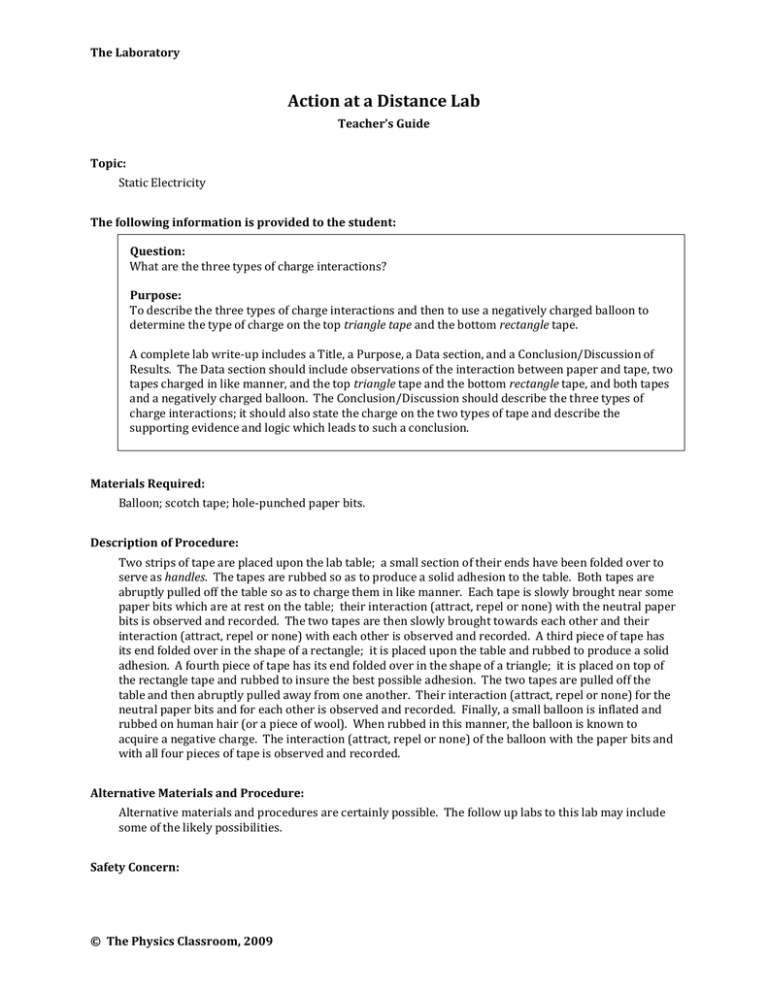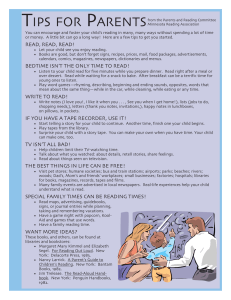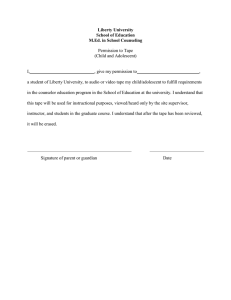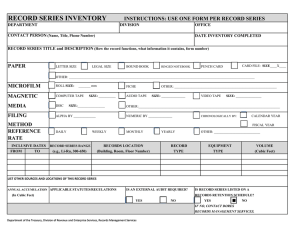Action at a Distance Lab
advertisement

The Laboratory Action at a Distance Lab Teacher’s Guide Topic: Static Electricity The following information is provided to the student: Question: What are the three types of charge interactions? Purpose: To describe the three types of charge interactions and then to use a negatively charged balloon to determine the type of charge on the top triangle tape and the bottom rectangle tape. A complete lab write-up includes a Title, a Purpose, a Data section, and a Conclusion/Discussion of Results. The Data section should include observations of the interaction between paper and tape, two tapes charged in like manner, and the top triangle tape and the bottom rectangle tape, and both tapes and a negatively charged balloon. The Conclusion/Discussion should describe the three types of charge interactions; it should also state the charge on the two types of tape and describe the supporting evidence and logic which leads to such a conclusion. Materials Required: Balloon; scotch tape; hole-punched paper bits. Description of Procedure: Two strips of tape are placed upon the lab table; a small section of their ends have been folded over to serve as handles. The tapes are rubbed so as to produce a solid adhesion to the table. Both tapes are abruptly pulled off the table so as to charge them in like manner. Each tape is slowly brought near some paper bits which are at rest on the table; their interaction (attract, repel or none) with the neutral paper bits is observed and recorded. The two tapes are then slowly brought towards each other and their interaction (attract, repel or none) with each other is observed and recorded. A third piece of tape has its end folded over in the shape of a rectangle; it is placed upon the table and rubbed to produce a solid adhesion. A fourth piece of tape has its end folded over in the shape of a triangle; it is placed on top of the rectangle tape and rubbed to insure the best possible adhesion. The two tapes are pulled off the table and then abruptly pulled away from one another. Their interaction (attract, repel or none) for the neutral paper bits and for each other is observed and recorded. Finally, a small balloon is inflated and rubbed on human hair (or a piece of wool). When rubbed in this manner, the balloon is known to acquire a negative charge. The interaction (attract, repel or none) of the balloon with the paper bits and with all four pieces of tape is observed and recorded. Alternative Materials and Procedure: Alternative materials and procedures are certainly possible. The follow up labs to this lab may include some of the likely possibilities. Safety Concern: © The Physics Classroom, 2009 The Laboratory There is always a higher than usual level of risk associated with working in a science lab. Teachers should be aware of this and take the necessary precautions to insure that the working environment is as safe as possible. Student horseplay and off-task behaviors should not be tolerated. Suggestions, Precautions, Notes: 1. 2. 3. 4. When conducting tests on the balloons, caution should be taken to bring the charged (i.e., rubbed) portion of the balloon near to the other object. This lab presents a great challenge to students in terms of thinking about how they might document and organize the wealth of observations which they will be making. Discuss the process in advance in order to promote better organization. Objects tend to lose their charge over time (especially in humid environments). The tapes may need to be re-charged if a second and a third test is conducted with them. Be aware of students who might be prone to allergic reactions to latex balloons. Auxiliary Materials: None Scoring Rubric: SE1. Action at a Distance Lab Included, labeled and organized all parts of the lab report. Data section includes clearly documented observations of interactions between the objects. Conclusion correctly and completely answers the question from the Purpose. The charges on the top triangle tape and the bottom rectangle tape are accurately stated; the supporting evidence is discussed. Connections to The Physics Classroom Tutorial: The following reading is a suitable accompaniment to this lab: http://www.physicsclassroom.com/Class/estatics/u8l1a.cfm http://www.physicsclassroom.com/Class/estatics/u8l1b.cfm http://www.physicsclassroom.com/Class/estatics/u8l1c.cfm Connections to Minds on Physics Internet Modules: Sublevels 1 and 2 of the Static Electricity module are suitable accompaniments to this lab: http://www.physicsclassroom.com/mop/module.cfm © The Physics Classroom, 2009 Score _____/_____




